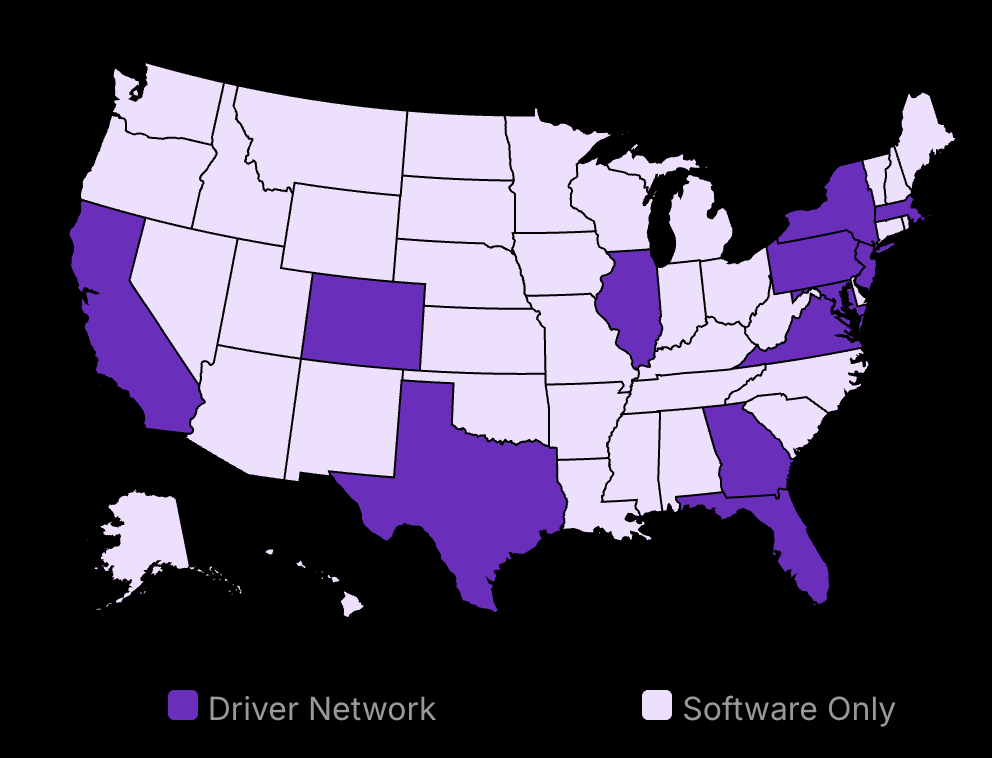Think your operational efficiency is at its peak? Think again.
Simply put, route optimization algorithms are game changers.
To put this into perspective, imagine your fleets achieving reduced overtime by 20%, lowering overall transportation costs by 30%, and drastically slashing vehicle wear and tear. Unlock these advantages and more by integrating advanced routing software into your logistics strategy.
However, did you know that the types of route optimization algorithms you choose can significantly impact your business operations?
Only the right algorithm has the power to supercharge your business efficiency, catapulting your ROI beyond expectations.
Welcome to the exciting world of route optimization algorithms – your secret weapon for a smooth sailing-business operation. Let’s revolutionize your business, one route optimization algorithm, at a time. Unleash the potential of optimizing your routes, and see how tailored route optimization solutions can transform your logistics and operational efficiency.
Route Optimization Algorithm Statistics
Route optimization can reduce mileage by 20-40% compared to manual route planning.
Unveiling the Power of Route Optimization Algorithms
Brief Introduction to Route Optimization Algorithms
Route optimization algorithms, a cornerstone of advanced logistics and distribution, dictate the most efficient routes and paths for goods, service teams, or data to travel. These intricate systems are drawn from complex mathematics and are the brainchild of innovative computer programming. Enhance your logistics strategy by leveraging the capabilities of planning multiple stops on a single journey, a strategy that promises significant savings in time, energy, and operational costs.
Defined as a methodical process of determining optimal routes, this innovative mechanism works by consolidating, analyzing, and leveraging various sets of data. These data points could range from traffic conditions and roadwork disruptions to vehicle availability, delivery time windows, and even driver work schedules.
For instance, in a fleet of delivery vans, the algorithm considers not only the shortest or fastest routes but also other variables that might impact delivery times and costs. Consequently, algorithms can often ferret out hidden efficiencies in real-world routing situations.
Importance of Route Optimization for Businesses
For businesses, conventional route optimization is far from an aftermarket luxury—it’s an operational necessity. Knowing the quickest, most efficient route saves not only time but also fuel, money, and resources, leading to higher productivity and lower costs. Explore how optimizing routes can transform your business operations, enhancing efficiency and cutting down expenses.
Take fuel consumption, for example. Trucks that know the most optimal route avoid unnecessary backtracking, saving fuel (and the costs associated with it) in the process. Fuel savings go right to the bottom line, increasing profits and improving the overall financial health of the company. Discover how Route Planning with Multiple Stops can significantly reduce fuel consumption by ensuring the most efficient paths are taken. Explore our blog for insights on leveraging this technology to boost your company’s profitability.
The same applies to human resources. Route optimization reduces overtime and stress, leading to happier, more efficient staff.
Moreover, in an era where customers demand super-quick services, efficient routing ensures faster delivery times and a more streamlined customer experience. It also enables businesses to keep their promises, whether that’s getting a package to a customer by a specific time or ensuring their consultant arrives for an appointment on the dot.
Besides, route optimization software often allows robust tracking and reporting. These insights can generate more accurate forecasting and planning, leading to enhanced operational efficiency.
Ultimately, the power of route optimization algorithms lies in their ability to turn complex logistics management into a more straightforward, economical, and efficient process. They streamline operations while generating significant cost savings, elevating the level of service businesses provide to their customers.
Benefits of Route Optimization
15-25% savings in mileage costs can be achieved through route optimization.

Lower your delivery costs by 23%
How we reduce costs:
- No delivery vehicle expenses
- Optimized local routes
- Pay-per-delivery model
- Average 23% delivery cost reduction
Discover the Different Types of Route Optimization Algorithms
The Simulated Annealing Algorithm: Your Solution to Complex Vehicle Routing Problem
The Simulated Annealing algorithm, widely recognized for solving robust scheduling assignments, navigates its way to the final solution by accepting not only improvements but certain deteriorations too. This tactic essentially prevents the algorithm from sticking to local optimum solutions and reaching the global optimal solution as one instead. How does the Simulated Annealing algorithm approach the challenge of the traveling salesman dilemma, thereby facilitating the discovery of efficient routes and schedules?
Simulated Annealing works by initially setting a high ‘temperature,’ which gradually ‘cools down.’ Each step involves a change in the current solution, leading to a transition in either a better or worse direction. This probabilistic stepping-stone approach makes it ideal for solving complex business problem and capaciated vehicle routing problems.
By providing reliable, efficient solutions to complex routing issues, this algorithm aids businesses in reducing operational costs and increasing worker productivity. By assuring global optimal solutions, it allows for the added advantage of flexibility in adapting to varying business conditions. Uncover the benefits of optimizing your routes using Google Maps, and learn how this can lead to significant savings and heightened efficiency in your business operations.
Genetic Algorithm: The Evolutionary Approach to Route Optimization
The genetic algorithm takes inspiration from nature’s evolution and genetics. It continuously evolves solutions to optimization problems based on principles of genetics and natural evolution, such as inheritance, mutation, and selection.
The genetic algorithm generates a pool of random solutions and improves upon these with each generation via a process resembling natural selection. The better solutions – or the ‘fittest’ individuals – survive to the next generation by reproducing more frequently. A phase of mutation introduces new genetic structures within the population, driving diversity within solutions.
This algorithm delivers creative, effective solutions to route optimization, not confined to the conventional approaches. Businesses benefit from its robustness and adaptability, providing optimal solutions, even when business conditions alter.
Ant Colony Optimization: Harnessing the Power of Swarm Intelligence
Drawing inspiration from the behavior of ant colonies and their food-seeking strategies, Ant Colony Optimization demonstrates how collective behavior can transform individual failures into collective success.
Ant Colony Optimization exploits a form of indirect communication and cooperative behavior of ants called stigmergy. Just as ants leave a trail of pheromones to guide others in the colony toward food, the algorithm creates artificial ‘ants that traverse possible routes, leaving a simulated pheromone trail that influences the probability of the path chosen by the following artificial ants.
Adopting Ant Colony Optimization can revolutionize route planning and scheduling tasks. The resilience of this algorithm in rapidly changing environments helps businesses create durable and efficient route plans. Hence, it aids in time-saving, and cost reduction, and improves overall operational efficiency.
Implementing Route Optimization Algorithm: A Step-by-Step Guide
Step 1: Identifying Your Business Needs
Clearly, understanding your business needs before implementing route optimization algorithms is paramount. It’s akin to embarking on a journey: you wouldn’t start driving without knowing your destination. The same principle applies here. Without clear needs in mind, you risk wasting time and resources on solutions that fail to deliver optimal benefits.
Analyzing your business needs requires a meticulous approach. Start by scrutinizing your current operations. Identify any areas that are not performing optimally, and ask yourself: could these issues be resolved through better routing? Dig deeper, and understand the factors causing inefficiencies, such as delivery times, fuel consumption, or employee productivity. Drawing on these insights, you can define clear needs that route optimization algorithms can address.
Step 2: Choosing the Right Algorithm for Optimal Routes
Selecting the right algorithm is not a cakewalk. Consider factors like computational speed, accuracy, scalability, and adaptability. For example, algorithm A may offer high speed but compromise on accuracy, while algorithm B may be slower but deliver precise results. Evaluate each option in relation to your previously identified business needs to find the optimal choice.
Aligning the chosen algorithm with your unique business needs ensures a perfect fit. Imagine you’re shopping for a suit: a one-size-fits-all approach seldom works. The same principle applies here. An algorithm tailored to your specific needs will serve you better, enabling an efficient, effective operation that bolsters your bottom line.
Optimized Routes
Optimized routes can result in 5-10% savings in fleet size by better allocating orders and vehicles.
Step 3: Integrating the Algorithm into Your System
How to integrate the chosen algorithm into the business system
Integrating the chosen algorithm into your system hinges on your existing tech stack and infrastructure. You might require API integrations, changes to your UI/UX, or backend tweaks. Approach this task methodically, developing a robust implementation plan that includes contingencies, set milestones, and clear ownership of each task.
Potential challenges and how to overcome them
The path to implementation may be paved with challenges, such as resistance to change, technical malfunctions, or a learning curve for staff members. These can be mitigated through comprehensive training sessions, phased roll-outs, and providing robust technical support to resolve issues promptly. Achieving your optimal routing transformation might be a trek, but it’s a journey well worth making.
The Intersection of Route Optimization Algorithms and Big Data
Understanding the Role of Big Data in Route Optimization
The successful implementation of any technology begins with understanding its functioning and relevance.
Big data is playing a paramount role in revolutionizing how businesses operate. When it comes to route optimization, the impact is not trivial. The comprehensive data, including geographical information, traffic patterns, and road conditions captured by big data, significantly contributes to the efficiency of route optimization algorithms.
These algorithms use this information to make better decisions that result in shorter routes, less delivery time and even decreased fuel consumption. The predictive capabilities of big data further push the boundaries of this benefit by forecasting possible disruptions and road impediments, enabling businesses to plan accordingly and hence maintain their operational efficiency.
Real-world examples of businesses leveraging big data for route optimization
Multiple businesses across various sectors are harnessing the power of big data to enhance their operations. Specifically, in the area of route optimization, logistics and transportation companies come on top. Discover how to fine-tune your journeys and cut costs by learning to optimize your routes using Google Maps, an invaluable tool for any logistics and transportation enterprise striving for efficiency.
For instance, the retail giant Amazon uses big data to power its unique delivery system. Analytics drawn from big data helps the company streamline its delivery process and establish efficient route paths, thereby saving time and resources. Another prominent example is UPS, which established its On-Road Integrated Optimization and Navigation (ORION) system that utilizes big data for route optimization, resulting in significant fuel savings and improved delivery time.
The above examples magnify the benefits that big data can provide when incorporated into the route optimization process. It allows businesses not only to improve their existing processes but also provides opportunities to discover new efficiencies and competitive advantages.
By now, you should understand the significant role big data plays in the realm of route optimization algorithms. These performances can further be enhanced, leading to more business benefits. Curious about the complexity behind routing large vehicles? Discover the intricacies involved in planning routes for trucks and how it diverges from standard navigation methods.
Benefits of Route Optimization Algorithms for Business Owners
Increased Efficiency and Productivity
Route Optimization Algorithms are no less than a blessing in disguise for businesses indulged in delivery, logistics, and field services. By designing the shortest and most convenient route for service handlers and drivers, these algorithms not only save time but also increase overall operational efficiency. Discover how optimizing your delivery routes can further enhance efficiency and reduce operational costs in your logistics operations.
Consider a pizza delivery service, for example. By integrating route optimization algorithms into their delivery system, they can design the shortest possible route for each delivery. This ensures that not only do the pizzas reach their destination hot and fresh, but the riders can also make more deliveries in less time. This helps increase delivery time windows overall productivity and service quality – which in turn increases customer satisfaction. Discover how utilizing delivery routing software can enhance operational workflows by ensuring timely, fresh pizza deliveries, optimizing route efficiency, and elevating customer satisfaction levels.
Importance of Route Optimization Software for Customer Satisfaction
83% of companies using route optimization software report improved customer satisfaction
Cost Savings
It’s not just the efficiency, vehicle capacity, and productivity that get a boost with route optimization; businesses can also save considerably on their fuel costs. With the shortest and least congested routes in hand, the vehicles cover less distance and take substantially less time, which directly translates to lower fuel consumption and maintenance costs. Discover how adjusting your routes dynamically can further enhance savings and efficiency in your logistics operations.
Moreover, by making more deliveries in less time, businesses can also minimize their need for a massive fleet of delivery vehicles. Thus, saving considerably on vehicle procurement and maintenance.
With these benefits, it is clear that route optimization algorithms aren’t just a luxury or an advancement, but a necessary investment for businesses in the present fast-paced and customer-oriented market. By boosting operational efficiency, cutting costs, and equipping businesses with data-driven decision-making insights, these algorithms can certainly give businesses an edge over their competitors.
Route Optimization Algorithm Statistics
78% of companies using route optimization software report reduced operational costs
Choosing the Right Route Optimization Software: What to Look For
Key Features of Effective Route Optimization Software
Route optimization software can supercharge business operations, but not all are made equal. At the core, it’s crucial to focus on a few standout features when making a selection. Understand the nuances of the vehicle routing issue and how selecting the right software can be a game-changer for optimizing your logistics and transportation paths.
Highlights include real-time tracking, what-if scenario analysis, and interactive mapping. Real-time tracking arms you with vital data on the go, ensuring fast, informed decisions. Scenario analysis empowers you with foresight, preparing your business for curveballs before they occur. Taking it up a notch, interactive mapping solutions provide visualized, easy-to-comprehend insights.
These features prove invaluable when optimizing the delivery routes themselves. Real-time tracking ensures operational adaptability, while scenario analysis equips businesses to face uncertainties head-on. With interactive mapping, navigating complex operational landscapes becomes a breeze.
Top Route Optimization Software in the Market
A condensed world of software choices awaits. It’s important to discern the crests and troughs of each before making a pick.
Some popular options include Routific, RouteXL, and OptimoRoute. Routific leads with its robust AI algorithms, while RouteXL boasts of its multi-stop route planning capability. OptimoRoute, on the other hand, stands out with its employee scheduling feature. Explore the advancements in complimentary route planning tools to enhance your journey management without the cost, featuring the likes of Routific, RouteXL, and OptimoRoute in the top picks for 2024.
No solution fits all situations, so weighing the pros and cons is vital. For instance, Routific’s AI might be exemplary, but may not be suitable for businesses not tech-enabled. Conversely, RouteXL’s multi-route planning could be overkill for smaller operations, and OptimoRoute’s employee scheduling might offer granular control but could be complex to manage.
Making the Final Decision: Aligning Software with Business Needs
Choosing the right software is not just about stacking features. Instead, businesses should prioritize aligning solutions with their specific needs.
A box full of features won’t do much good if your business doesn’t need most of them. Instead of going for the software with the most bells and whistles, select one that aligns closely with your operational needs for maximum returns.
Some tips to close in on the decision might include conducting a cost-benefit analysis, considering scalability, and obtaining extensive product demos. Remember, low-priced software might not always drive value, while an expensive one may not necessarily align with your needs. Scalability matters because as your business grows, so should the capabilities of your chosen software.
Each part of this guide is a stepping stone. Take your time, evaluate your choices, and make an informed decision that optimizes the efficiency of your operations. And always remember, it’s not about the best software in the market, it’s about the software that’s best for you.
The Gloval Route Optimization Software Market
The global route optimization software market is expected to grow from $3.8 billion in 2022 to $6.2 billion by 2027.
Charting a Roadmap to Increased Efficiency
Route optimization algorithms are a valuable tool, potentially driving down costs and ramping up productivity. They streamline crucial business operations, giving your business the edge it needs in today’s competitive market.
You’ve learned about the power of these algorithms. Now act on it. It’s time to inject that efficiency into your operations. Prioritize integrating innovative technologies like optimize routes into your business strategy.
Does your business have room for a more efficient approach to logistics and operations? Consider how route optimization could supercharge your business procedures.
As we navigate the winding path of business, remember this – any map is only as good as the route it sketches. Equip yours with route optimization algorithms, and watch the journey to success become a practical reality. Take the wheel and steer your enterprise toward the route of maximized efficiency.




























